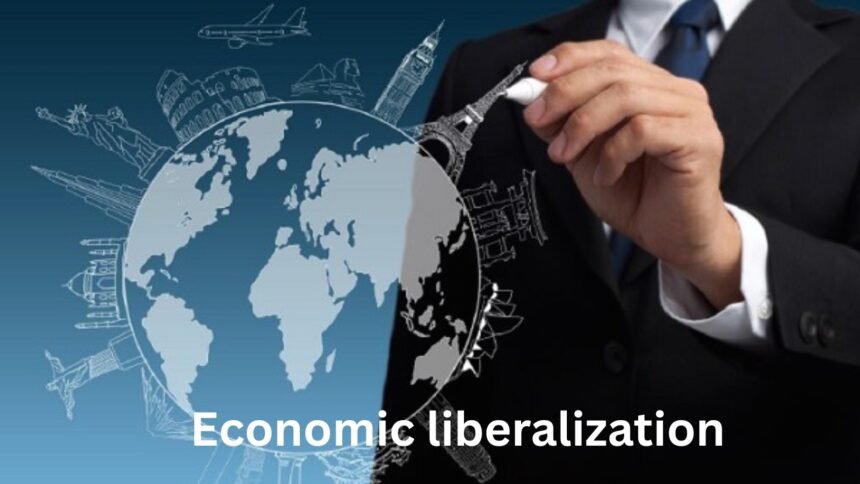Economic liberalization has become one of the most pivotal shifts in global economic policy over the past few decades. In simple terms, it refers to the process of reducing government restrictions on economic activity to promote a more free-market system. This transformation has had profound implications for both developed and developing countries. In the context of America, economic liberalization has played a key role in reshaping industries, facilitating trade, and inspiring innovation. As countries increasingly embrace this technique, they unlock opportunities for global growth, foster competitive markets, and enhance economic dynamism.
In this article, we’ll explore the significance of economic liberalization, particularly within the U.S., its impact on global markets, and the challenges that come with it. We will also reflect on how these shifts have affected the average American worker and consumer, and consider the long-term ramifications of these policies on the global stage.
Understanding Economic Liberalization
Economic liberalization refers to the process by which a country reduces its restrictions on economic activity. This often involves deregulating industries, reducing tariffs, and privatizing state-owned enterprises. The goal is to create a more open and competitive market environment, where both domestic and foreign businesses can compete freely. In the U.S., this has manifested in various forms, from free trade agreements to tax policies designed to reduce barriers to business operations.
As countries progressively reduce state intervention in their economies, they aim to stimulate growth, enhance efficiency, and improve the overall welfare of their citizens. In the U.S., economic liberalization gained traction in the late 20th century under leaders like President Ronald Reagan, who championed free-market principles through tax cuts, deregulation, and trade liberalization.
The Historical Context of Economic Liberalization
Economic liberalization is not a new concept. It has its roots in classical economic theories that advocate for free markets, competition, and limited government intervention. In the post-World War II era, however, the global economy was primarily governed by the Bretton Woods system, which emphasized international cooperation and trade regulation. However, as the world entered the late 20th century, the collapse of the Soviet Union and the increasing globalization of markets pushed countries toward more market-oriented policies.
In the U.S., the period after the 1970s saw rising inflation, economic stagnation, and growing concerns over the inefficiencies of state-driven economic policies. The rise of economic liberalization in the 1980s was in response to these challenges, with leaders advocating for deregulation and reducing government control over industries. This era also marked the signing of trade agreements such as the North American Free Trade Agreement (NAFTA), which further integrated the U.S. into the global market.
The Key Components of Economic Liberalization
Deregulation is one of the core components of economic liberalization. This process involves removing regulations on industries that were previously controlled by government policies. In the U.S., deregulation began in the 1980s under President Reagan’s administration, particularly in industries like telecommunications, airlines, and banking. The aim was to enhance competition, lower prices, and improve service quality by allowing market forces to dictate outcomes rather than bureaucratic controls.
For instance, the deregulation of the airline industry in the 1970s led to a significant reduction in ticket prices and an increase in the number of available flights. Similarly, the banking sector saw massive changes, allowing for more competitive lending practices and improved access to financial services for businesses and individuals.
Trade Liberalization
Trade liberalization involves reducing tariffs, import quotas, and other barriers to international trade. The United States has been a key proponent of free trade, as seen in its numerous trade agreements, such as NAFTA, the World Trade Organization (WTO) agreements, and various bilateral trade deals.
By removing trade barriers, economic liberalization enables countries to access a broader range of goods and services, often at lower costs. This opens up new markets for American businesses and allows consumers to benefit from a greater variety of products. However, trade liberalization also presents challenges, particularly for industries that struggle to compete with cheaper imports.
Privatization of State-Owned Enterprises
Privatization is another essential aspect of economic liberalization. This involves transferring the ownership and operation of state-owned enterprises to private individuals or companies. The goal of privatization is to improve efficiency, reduce government spending, and increase competition in previously monopolized sectors.
In the United States, privatization has been most prominent in sectors like transportation, energy, and healthcare. For example, many local utilities that were once government-run have been sold to private companies, leading to greater competition and innovation within these industries.
The Impact of Economic Liberalization on the U.S. Economy
One of the most significant impacts of economic liberalization on the U.S. economy is the exponential growth in international trade. By opening up markets and reducing barriers to entry, liberalization has allowed American companies to expand their reach globally. The U.S. has become a leader in exporting goods and services, ranging from technology and automobiles to agricultural products and finance.
The U.S. economy has also benefited from the influx of foreign goods, which helps to keep prices lower for consumers. This increased competition has pushed American companies to become more efficient and innovative, which in turn drives overall economic growth.
Challenges to Domestic Industries and Workers
While economic liberalization has brought many benefits, it has also posed challenges for certain sectors of the U.S. economy. As trade barriers fell, American industries such as manufacturing found themselves competing with cheaper foreign labor. This has led to job losses in certain sectors and a decline in wages for some workers, particularly in industries like steel and textiles.
For many American workers, the transition to a more globalized economy has been painful. As jobs were outsourced to countries with lower labor costs, communities that relied on manufacturing became economically distressed. The rise of automation and offshore production has contributed to the decline of unionized labor in traditional industries, making it more difficult for workers to negotiate higher wages and better working conditions.
Innovation and Competitiveness
Despite these challenges, economic liberalization has spurred innovation in the U.S. economy. The increased competition in the global marketplace has forced American companies to be more creative and adaptable. From the tech industry to pharmaceuticals, U.S. companies have been at the forefront of technological advancements that have changed the world.
The ease with which businesses can now operate across borders has also facilitated the rapid exchange of ideas and expertise. For example, Silicon Valley has become a hub for global collaboration, attracting top talent from all over the world and driving technological progress that has had a transformative impact on the global economy.
Expert Insight
Economist Joseph Stiglitz, who won the Nobel Prize in Economic Sciences, argues that “Economic liberalization can offer tremendous benefits, but it must be carefully managed to avoid exacerbating inequalities.” Stiglitz’s insight highlights the delicate balance that must be struck between promoting free markets and ensuring that the benefits of economic liberalization are broadly shared across society. Without adequate safeguards and policy measures, the rewards of liberalization may be concentrated among a few, leaving vulnerable populations to bear the brunt of its costs.
The Global Impact of Economic Liberalization
Economic liberalization has not only transformed the U.S. economy but has also had a profound impact on emerging markets around the world. Countries like China, India, and Brazil have embraced liberalization policies, which have fueled rapid economic growth and lifted millions out of poverty. As these nations continue to integrate into the global economy, they present new opportunities for American businesses to expand and invest.
However, the rise of emerging markets also presents challenges. As these countries develop their own industries and infrastructures, they become increasingly competitive on the global stage. U.S. companies must adapt to these changing dynamics by continuing to innovate and seek out new markets for their products.
The Debate Over Economic Liberalization
While the benefits of economic liberalization are evident, there is ongoing debate about its long-term consequences. Critics argue that liberalization can exacerbate income inequality, undermine social safety nets, and lead to environmental degradation. Supporters, on the other hand, contend that liberalization creates jobs, drives innovation, and fosters economic growth.
As the global economy continues to evolve, policymakers must weigh the trade-offs associated with economic liberalization. Striking a balance between free-market principles and social welfare programs is crucial for ensuring that the benefits of liberalization are felt by all.
Conclusion
Economic liberalization has undoubtedly reshaped the global economic landscape, with significant implications for the United States. While the U.S. has benefited from increased trade, innovation, and economic growth, it has also faced challenges in terms of job losses and rising inequality. As the world becomes more interconnected, economic liberalization will continue to play a central role in shaping the future of global trade and development.
The key to maximizing the benefits of liberalization lies in managing its impact on society. Ensuring that workers are retrained, providing support for affected industries, and ensuring that the global economy remains sustainable are critical steps in the ongoing process of economic transformation. Ultimately, the challenge will be finding a way to harness the power of liberalization while ensuring that it serves the interests of all members of society, both domestically and globally.
you may also read
Business Property for Rent: Unlock Success with the Perfect Space






